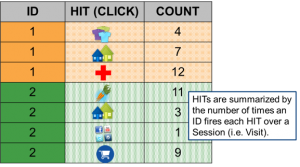The business opportunity to intelligently manage customer journeys across their lifecycle with your brand has never been greater, but so is the danger of not meeting their expectations and losing out to savvier competitors. In my opinion, the current state of most digital analytic practices continue to be siloed, tactical, and narrowly fixated on channel-obsessed dashboard reporting. That might come across as presumptuous, but keep this in mind - customer-centricity is a hot topic at the C-Suite level, and your CMO has stated (or will very soon) that your organization is transforming into a personalization super force that will be marketing to the segment of one. If that is the case, the category of digital analytics has got to step up its game!
The antidote is digital intelligence which represents a strategic shift in approach to marketing analysis that uses insights from traditional and modern channels (we're talking online AND offline) to enable actionable, customer-obsessed analytical brilliance.
The era of the empowered customer is unraveling itself — trends in which consumers, not brands, own influence, backed by the rapid rise of digital. I strongly believe that no matter how important a company's products or services are with my life, the majority of brands I do business with continue to perform channel-centric analysis, and remain unaware of the different interactions I have with them across ALL channels. I don't care about your email or search marketing KPIs. What I care about is how you treat Suneel, no matter what device, channel, or platform I select to interact with you on.
Meanwhile, digital marketing spend continues to grow at a tenacious pace, cementing the importance of digital channels in managing the customer journey. Digital marketing is effective in all phases of the customer life cycle, ranging from acquisition, upsell/cross-sell, retention, and winback, proven by the ongoing shift of wallet share to online channels. While these are exciting times for omnichannel marketers, these more holistic approaches bring challenges. In today's fragmented digital landscape, long-established methods focused on web analytics and aggregated customer views are ill-equipped to keep pace with:
Digital interaction bread crumb trails
Customers (and prospects) interact with brands across an array of online channels and devices, creating new paths to generate incremental value associated with marketing-centric KPIs. However, customers expect personalized relevance in moments of truth, raising the bar for analytics and marketing execution. A brand's digital presence is much more than a website, such as social media, mobile applications, and wearable technologies. Conventional web analytics only track onsite behavior and lack the ability to comprehend tech-savvy customers in 2016.
The collapse of the digital silo
Brands typically construct offline and online interaction channels confined from one another, so let's reflect on that for a moment. Isn't it time we recognize that customer data is customer data, regardless of where the ingredients are collected? To deliver comprehensive customer insights, brands seek to merge digital and offline data sources together. Digital & customer analytics teams are attempting to work together, but their projects struggle due to a clash of approaches & culture. Some of the main drivers are:
- Data — Customers leave trails of information for marketers to chew on, and are available in structured, semistructured, and unstructured formats. There's no excuse anymore for brands to not be able to work with all three. Approachable technology exists to integrate multiple sources of online and offline customer data in meaningful ways to analyze and take action on.
- Skills — Have you ever sat in a meeting with data scientists and web analytic ninjas? It's like they speak two different langua
 ges, and communication between these two segments is critical for an organization to innovate in its commitment to customer analytics.
ges, and communication between these two segments is critical for an organization to innovate in its commitment to customer analytics. - Analysis — There is a reason why there is so much discussion around the application of advanced analytics. In many ways, digital marketing is ripe for analytical maturity, ranging across segmentation, attribution, and personalization. The discipline has proven its value to help differentiate a brand from its competition. When are the days of “good enough” analytics going to end? Let's keep the science in data science, and stop succumbing to the false hype that sophisticated predictive marketing can be accomplished through black box, easy-button solutions.
Dynamic interaction management
Brands seek to react intelligently to shifts in consumer behavior in milliseconds, which makes the intersection of predictive analytics and data-driven marketing vital for orchestrating the customer journey. To reach your target audience in opportunistic micro-moments, the requirement of real-time actionable analytics with direct connections to personalization and marketing automation systems is the queen bee. The sole dependence on isolated, retrospective reports and dashboards of aging web analytic solutions has serious limitations in modern marketing.
Given the investment and revenue at stake for most brands, it is increasingly important to champion support of the development and continuous optimization of digital channels. Simply put, analytical sophistication lives at the center of that process. Yet most organizations continue to approach digital analytics focused on discerning traffic sources and aggregated website user behaviors. Given the intricate complications and aspirational promise of digital marketing, brands should consider modernizing and maturing their approaches to customer analytics because:
- CX matters: Customers don't care about the challenges related to identity management across multiple visits (or sessions), browsers, channels, and devices. Does your web analytic platform support your team's abilities to recognize and track customers, not clicks or hits, across the fragmentation of touch points? With careful consideration towards the areas of data management, data integration, and data quality, analyzing customer-centric (or visitor-centric) digital activity on their journeys to making (or not making) a purchase with your brand is absolutely feasible.
- "Good enough" analytics must end: Digital analytic teams must graduate from machine gunning their organizations with traffic-based reports that summarize the past to producing predictive insights that marketers can interpret, and take action with. I'm always impressed by web analytic teams that produce an array of historical reports with beautiful visualizations, segmenting and slicing away at their tsunami of clickstream data. However, how much impact and relevance to the business can this approach have? Customer-centricity demands that we re-engineer our thinking, and make the shift from reactive to predictive marketing analytics.
- There's nothing exciting about siloed channel analysis: To deliver the elusive and mythical 360 degree view of customer insights, it turns out you don't need magical wizards like Gandalf or Albus Dumbledore by your side. Have you ever wondered why web analytic software doesn't allow you to perform data stitching with offline data sources? How about data mining and predictive analytic capabilities? Well, it boils down to how digital data is collected, aggregated, and prepared for downstream use cases.
Web analytics has always had a BIG data challenge to cope with since it's inception in the mid 1990's, and when the use case for analysts is to run historical summary reports and visual dashboards, clickstream data is collected and normalized in a structured format as shown in this schematic:

This format does a very nice job of organizing clickstream data in such a way that we go from big data to small, more relevant data for reporting. However, this approach presents challenges when performing customer-centric analysis which requires data stitching across online and offline data sources. Why you ask? Because you cannot de-aggregate data that was designed for channel and campaign performance summarizations. Holistic customer analysis, from a digital viewpoint, requires the collection and normalization of granular, detailed data at an individual level. Can it be done? Of course it can.
Multi-source data stitching, data mining and predictive analytics require a specific digital data collection methodology that summarizes clickstream data to look like this:
Ultimately, the data is collected and prepared to contextually summarize all click activity across a customer's digital journey in one table row, including a primary customer key to map to all visits across channels and devices. The data table view shifts from being tall and thin, to short and wide. The more attributes or predictors an analyst adds, the wider the table gets. The beauty of this approach is it allows marketers and analysts to be curious, add more data sources, and allow algorithmic analysis to prioritize what is important, and what isn't. This concept is considered a best practice for advanced customer analytics.
- Beware of blind spots: As time passes, customers in every industry are progressively sharing more data about themselves through existing and emerging digital outlets, such as mobile applications, wearables, and other connected technology. The opportunity to ingest and analyze these new sources should excite any marketer who claims to be data-driven. However, does your web analytics platform allow you to analyze these new digital touchpoints? A brand's ability to absorb, integrate, analyze, and derive marketable insights from emerging data sources is key in this new paradigm to avoid being blindsided by customers and the competition.
The path to digital intelligence from traditional web analytics needs to cover the diversity of data, advanced analytic techniques, and injection of prescriptive insights to support decision-making and marketing orchestration. Digital intelligence is a transformation for web analytic teams — making it a competitive differentiator if executed well. It aims to transform brands to become:
- Customer-centric rather than channel-centric: As customers and prospects weave across an ocean of marketing channels and connected devices, digital intelligence supports the integrated analysis of interactions in concert, rather than with disconnected channel views. In addition to visibility across all channels, analysis is highly granular to identify, track, and prioritize next-best-actions for individuals. In other words, hyper-personalization to the segment of one!
- Focused on enterprise goals as opposed to departmental: To enable omnichannel analytics, digital intelligence is highly dependent on customer data management capabilities across all data types – structured, semistructured, and unstructured. This includes fusing interaction and behavioral data across all digital channels with first-party offline customer data, as well as second- and third-party data (if available). This enriched potpourri of data must be prepared to feed the analytical ninjas that sit within the marketing organization, line of business or centralized customer intelligence team, because it is their job to exploit this stream of information and generate insights for the organization as a whole.
- Enabled for audience activation and optimization. The mission of digital intelligence is the direct application of analytics to generate data-driven evidence that helps business stakeholders make clearer decisions. The potential of data mining exponentially increases with richer customer data to support segmentation, personalization, optimization, and targeting - in other words, connecting data and analytics to the delivery of relevant content, offers, and awesome experiences.
- Analytical workhorses: The incredibly fast-moving world of digital interactions and campaigns mean that marketers desperately need quicker analysis. Waiting days or weeks for reports and research equates to failure. Digital intelligence delivers efficiency at a pace that more nearly matches users' decision-making schedules.
SAS Customer Intelligence offers a one-stop modern marketing platform to comprehensively support the mission of digital intelligence - from digital data collection, management, predictive analytics, and marketing delivery across online and offline channels. On April 19 at SAS Global Forum 2016, SAS Customer Intelligence 360 will make its debut, and digital intelligence will be a primary topic. This new offering will drive unprecedented innovation in customer analytics, putting predictive analytical intelligence directly in the hands of digital marketers, business analysts, and data scientists. In the last few months, industry analysts have previewed and validated our abilities in advanced and customer analytics.
We are very excited for the future and potential of digital intelligence. The question is...
Are you excited?
If you enjoyed this article, be sure to check out my other work here. Lastly, if you would like to connect on social media, link with me on Twitter or LinkedIn.

